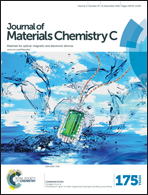Comparative study of the conformational effect of dithienothiophene- and terthiophene-based photovoltaic polymers
Abstract
The conformational change of the polymer backbone has an obvious influence on the blended film morphology and the photovoltaic properties. A planar polymer backbone can provide strong intermolecular interaction, but excessive self-aggregation usually disadvantages a favorable film morphology. Here, a dithienothiophene (DTT) unit and a terthiophene (T3) unit were introduced to construct a pair of new conjugated polymers, PDTT-DTBT and PT3-DTBT, respectively, to investigate the correlation between the conformation of the polymer backbone and the photovoltaic properties. The highly planar structure of the DTT unit made PDTT-DTBT exhibit a stronger molecular aggregation than PT3-DTBT. Compared to the DTT unit, the T3 unit changed the molecular structure from fused thiophenes to linked ones, which relaxed the rigidity of the polymer backbone and reduced the degree of polymer self-aggregation, and a more suitable blended film morphology was formed. Due to the weaker electron-donating ability of the DTT unit, PDTT-DTBT/PC71BM-based devices showed a higher open circuit voltage (Voc) of 0.75 V, and a power conversion efficiency (PCE) of 8.01% was obtained with a short-circuit current (Jsc) of 14.85 mA cm−2 and a filled factor (FF) of 71.62%. This PCE value was slightly higher than for PT3-DTBT/PC71BM-based devices, which exhibited a PCE of 7.68% (along with a Voc of 0.66 V, a Jsc of 16.62 mA cm−2 and a FF of 69.69%).


 Please wait while we load your content...
Please wait while we load your content...